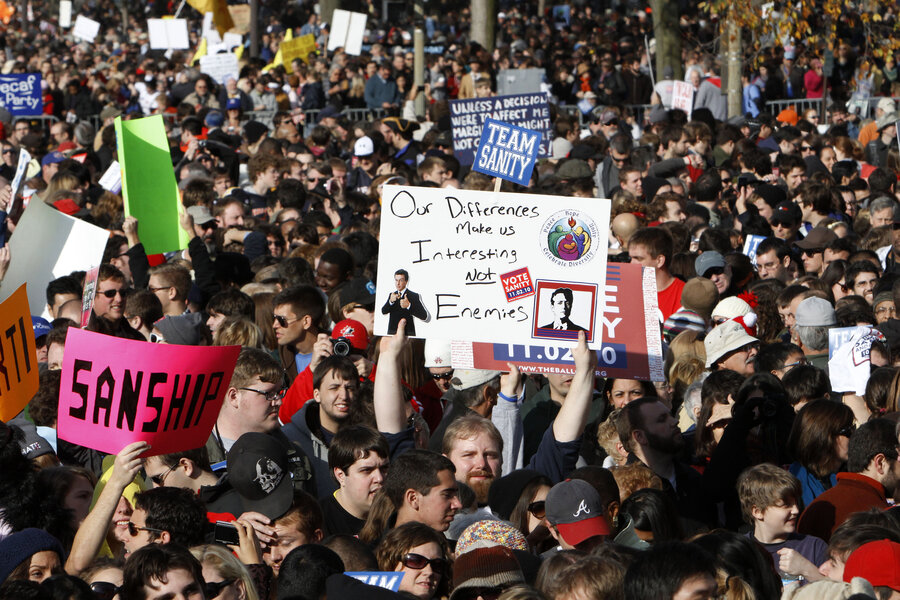America divided? Not in these hundreds of communities.
After enduring a toxic year-long mudslinging contest, it is all too easy to conclude that civility is dead.
It certainly seems that America is divided. Not only have the two major parties pulled further apart, but our culture as a whole – media, business, universities, you name it – seems to be increasingly polarized.
Television networks such as Fox News and MSNBC are clearly politically aligned, and the Internet has given each of us the opportunity to surround ourselves with news that fits our opinion. Research confirms that corporate boards of directors are overwhelmingly “red” (by an almost 2-to-1 ratio). By contrast, university faculties are overwhelmingly blue (almost two-thirds identify as “far left” or “liberal”).
Given this polarization, it is natural to feel disheartened and to fear that America is becoming completely politically segregated. But the good news is that hundreds of communities across the country are going in just the opposite direction. They are becoming vibrant places where citizens from across the political spectrum are working together to strengthen the civic fabric and revitalize democracy.
Because of my work as a mediator and my writing about leadership across the left-right divide, I have been privileged to witness firsthand places and people who still know how to sit down and talk through the challenges they face and find common ground. We can find this “America the beautiful” almost wherever we live in America today.
At the height of the chaos of the 2016 primaries, I found myself in front of 250 citizens in Hartford, Conn., that included supporters of Hillary Clinton and Bernie Sanders as well as Donald Trump, Ted Cruz, and Marco Rubio. These diverse civic leaders – working at hospitals and universities and civic organizations, living in every part of the metropolitan area – had come together as members and guests of Leadership Greater Hartford (LGH).
“Our recent meetings have confirmed,” LGH’s president Ted Carroll told me recently, “that people from different backgrounds are yearning for opportunities to learn from one another, and to work with each other to solve common concerns. When we create trusting, respectful spaces, we have seen time and time again that genuine dialogue leads to powerful collaborations.”
Now if you think this is an isolated example, think again. The civility that Mr. Carroll and his colleagues have cultivated in Hartford can be found in literally hundreds of other cities across America with similar cross-spectrum leadership networks.
“For decades, a community leadership movement has flourished across the country,” says Wendy Thomas, chair of the Association of Leadership Programs. “These programs bring together established and up-and-coming leaders from diverse backgrounds and perspectives to explore the opportunities and challenges facing their community.” In addition to discussing the complexities of public policy, says Ms. Thomas, they are becoming “servant leaders” who are dedicated to “making their cities stronger.” (For a full list of these cities, see the Association of Leadership Programs.)
This network of leadership programs is only one of many incubators of civility. In one organization alone, Everyday Democracy, hundreds of communities have begun the hard work of facing tough, divisive issues with courage and respect.
There are dozens of organizations like Everyday Democracy that also have touched the lives of Americans across the country. From Village Square in Tallahassee to American Public Square in Kansas City to Kitchen Table Democracy in Portland, Ore., civility-focused organizations are springing up in virtually every corner of country. (For a quick bird’s-eye view of more than 40 such organizations, go to Bridge Alliance.)
The civility revolution is particularly strong within 90 million members of the Millennial generation. Never in recent history has there been a generation so committed to independence from the two political parties, which have been come of age in an era of chronic hyperpolarized stalemate. It is no wonder that the Millennial Action Project, which is organizing the young members of Congress from both parties, have achieved remarkable momentum. In fact, not only have they created a cross-party “Future Caucus” on Capitol Hill, but in more than a dozen state legislatures as well.
In government as well as in communities, there are so many of these “pockets of civility” that they raise a powerful question: Is America actually divided?
If one goes to a Trump or Clinton rally, the answer appears to be obvious. Yes. But if you visit scores of communities where Americans live and work and raise their families, the answer – fortunately – is no.
E pluribus unum is our nation’s motto for a reason. “Out of many, one” means we can be different and still be Americans. If we look beyond the “red” and the “blue,” we discover the Technicolor civility of America.
Mark Gerzon, president of Mediators Foundation, is the author of "The Reunited States of America: How We Can Bridge the Partisan Divide."





